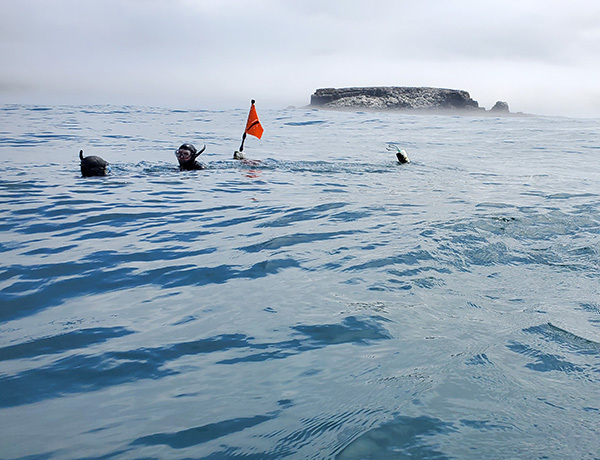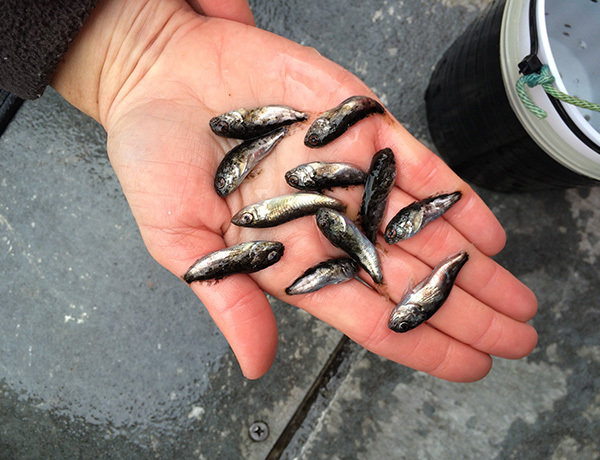Fish Report for 8-28-2023
SMURFs help scientists survey juvenile rockfish at Oregon Marine Reserves

by ODFW
8-28-2023
Website
Newport, Ore. – Cameron Royer is looking to see just how well this year’s batch of baby rockfish are faring off the Central Oregon coast, and he’s relying on a SMURF to reveal it.
No, not the blue cartoon characters. But a Standard Monitoring Unit for the Recruitment of Fishes – a $15 burrito-like bundle of snow fencing and wire that is a baby rockfish magnet when deployed barely a mile off the Oregon coastline.
These SMURFs are the best way to corral infant cabezon, black rockfish and other species as they make their way toward near-shore reefs and other habitats where some will live for decades. These rockfish, some barely an inch long, take refuge in the SMURFs’ plastic mesh and their numbers help researchers track the relative spawning successes of key rockfish species that are the backbone of Oregon’s sport and commercial bottomfish fisheries.
“These SMURFs are ideal habitat, imitating floating kelp or other marine debris that are like nurseries for these young rockfish,” says Royer, an Oregon State University researcher. “It’s perfect habitat and it’s great to use low-budget tactics.”
SMURFs are being deployed this summer and fall in two Oregon Marine Reserves and nearby comparison areas to get a snapshot of this year’s rockfish recruitment as part of an annual partnership between the Oregon Department of Fish and Wildlife’s marine reserves, OSU and the Oregon Coast Aquarium.
OSU and the aquarium partner with the Marine Reserves Program at Otter Rock Marine Reserve near Lincoln City. OSU, the marine reserves and a private company called South Coast Tours handle SMURFing duties at and near the Redfish Rocks Marine Reserve south of Port Orford.
Each year rockfish spawn in deep waters, and the young progeny make their way toward shore, mostly swimming in the top few feet of water. They look for kelp and floating debris to hide from predators before eventually making it to rocky reefs.
Fisheries managers always look for as much information as they can to gauge recruitment levels of new fish to the populations.
That’s why SMURFs are so handy. Each are about 4 feet long and are attached just below the surface and beneath buoys held in place by weights. Every two weeks, Royer and two volunteers use snorkel gear to dive and retrieve the SMURFs that are held individually in mesh bags.
Once taken to the boat, the SMURFs are shaken and rinsed with water to get the juvenile fish out of the mesh.
“You feel like you’re holding in your hand the future of a fishery,” says Kirsten Ann Grorud-Colvert, who heads the research at OSU. (how to say Grorud-Colvert How to pronounce my name)
The fish are identified, counted, anesthetized and taken to OSU’s lab for measurements and even DNA work.
A new, clean SMURF is put in its place.
The SMURF technology dates back to the early 2000s off Central California, with OSU and the marine reserves partnering in this data collection effort in Oregon over the past 11 years.
Four SMURFs are stationed inside the reserves like Otter Rock Marine Reserve, where fishing is banned and set aside for research like this. Four others are in a nearby comparison area where no restrictions exist.
Some years, like this one, well over 100 juvenile rockfish are collected from the eight SMURFs. Some years it’s close to zero.
SMURF data help generate long-term understandings of when various rockfish species have good and bad recruitment years. The data show up in places like the Oregon Department of Fish and Wildlife’s recent black rockfish assessment.
“This helps us see how things are changing,” Grorud-Colvert said. “We really need to see the big picture.”
Enacted by the Oregon Legislature in 2009, the Marine Reserves Program includes five actual marine reserves and nine protected areas that together cover nine percent of Oregon’s near-shore ocean waters.
The reserves, where no plants or animals can be removed and where development is banned, are underwater listening stations tracking ocean changes including fish, invertebrate and algal communities.
It is the first long-term nearshore ocean conservation and monitoring program run by the state of Oregon and includes cutting-edge research on the economic, social and cultural dynamics of the Oregon coast and coastal communities. The program is funded through state general fund dollars and not sport or commercial fishing fees.
Photos
More Reports

8-25-2023
SALEM, Ore.—Beginning Saturday, Aug. 26, ocean salmon anglers may keep any coho (unmarked e.g. unclipped or marked/clipped) when fishing from...... Read More

8-18-2023
SALEM, Ore.—Wild coho fishing regulations in rivers along Oregon's coast were posted online at MyODFW.com today. See regulations at the Recreation Report /...... Read More

Website Hosting and Design provided by TECK.net
